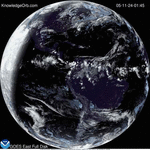
The ESA and NASA Solar Heliospheric Observatory (SOHO) captured these images of the sun spitting out a coronal mass ejection (CME) on March 15, 2013, from 3:24 to 4:00 a.m. EDT. This type of image is known as a coronagraph, since a disk is placed over the sun to better see the dimmer atmosphere around it, called the corona. Credit: ESA&NASA/SOHO
The last few days have seen many space weather warnings and alerts. The root of all of these was activity on the sun resulting in a strong a coronal mass ejection (CME) on Match 15th 2013 which hit Earth’s magnetic field at 0600 UT on March 17th. The impact was strong, lifting the solar wind speed from 300 km/s to greater than 600 km/s. High-latitude sky watchers should be alert for auroras.
The sun eruption is an Earth-directed coronal mass ejection (CME), a solar phenomenon that can send billions of tons of solar particles into space and can reach Earth one to three days later and affect electronic systems in satellites and on the ground. Experimental NASA research models, based on observations from the Solar Terrestrial Relations Observatory (STEREO) and ESA/NASA’s Solar and Heliospheric Observatory, show that the CME left the sun at speeds of around 900 miles per second, which is a fairly fast speed for CMEs. Historically, CMEs at this speed have caused mild to moderate effects at Earth.
The NASA research models also show that the CME may pass by the Spitzer and Messenger spacecraft. NASA has notified their mission operators. There is, however, only minor particle radiation associated with this event, which is what would normally concern operators of interplanetary spacecraft since the particles can trip on board computer electronics.
Not to be confused with a solar flare, a CME is a solar phenomenon that can send solar particles into space and reach Earth one to three days later. Earth-directed CMEs can cause a space weather phenomenon called a geomagnetic storm, which occurs when they connect with the outside of the Earth’s magnetic envelope, the magnetosphere, for an extended period of time. In the past, geomagnetic storms caused by CMEs such as this one have usually been of mild to medium strength
You can monitor current space weather on the KnowledgeOrb space weather page. Aurora viewing updates can be seen on the KnowledgeOrb Aurora viewing page. If you would like to get an email any time there is a Space Weather event subscribe to the KnowledgeOrb Space Weather Email Service.
See full Warning below:
Geomagnetic K-index of 6 Threshold Reached: 2013 Mar 17 0842 UTC Synoptic Period: 0600-0900 UTC Active Warning: Yes NOAA Scale: G2 - Moderate NOAA Space Weather Scale descriptions can be found at www.swpc.noaa.gov/NOAAscales Potential Impacts: Area of impact primarily poleward of 55 degrees Geomagnetic Latitude. Induced Currents - Power grid fluctuations can occur. High-latitude power systems may experience voltage alarms. Spacecraft - Satellite orientation irregularities may occur; increased drag on low Earth-orbit satellites is possible. Radio - HF (high frequency) radio propagation can fade at higher latitudes. Aurora - Aurora may be seen as low as New York to Wisconsin to Washington state.







